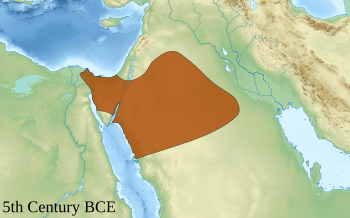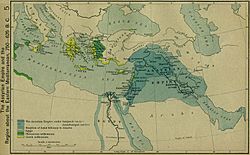Qedarites facts for kids
Quick facts for kids
Qedarite Kingdom
مملكة قيدار
|
|||||||
|---|---|---|---|---|---|---|---|
| 8th century BC–2nd century BC | |||||||

Kedarites in the 5th century BCE
|
|||||||
| Capital | Dumah | ||||||
| Common languages | Old Arabic Aramaic |
||||||
| Religion | North Arabian polytheism | ||||||
| Government | Monarchy | ||||||
| King | |||||||
| Historical era | Antiquity | ||||||
|
• Established
|
8th century BC | ||||||
|
• Absorbed into the Nabataean state
|
2nd century BC | ||||||
|
|||||||
The Qedarite Kingdom, or Qedar (Arabic: مملكة قيدار, romanized: Mamlakat Qaydar, also known as Qedarites), was a largely nomadic, ancient Arab tribal confederation. Described as "the most organized of the Northern Arabian tribes", at the peak of its power in the 6th century BCE it had a kingdom and controlled a vast region in Arabia.
Biblical tradition holds that the Qedarites are named for Qedar, the second son of Ishmael, mentioned in the Bible's books of Genesis (25:13) and 1 Chronicles (1:29), where there are also frequent references to Qedar as a tribe. The earliest extrabiblical inscriptions discovered by archaeologists that mention the Qedarites are from the Neo-Assyrian Empire. Spanning the 8th and 7th centuries BCE, they list the names of Qedarite kings who revolted and were defeated in battle, as well as those who paid Assyrian monarchs tribute, including Zabibe, queen of the Arabs (šar-rat KUR.a-ri-bi). There are also Aramaic and Old South Arabian inscriptions recalling the Qedarites, who further appear briefly in the writings of Classical Greek, such as Herodotus, and Roman historians, such as Pliny the Elder, and Diodorus.
It is unclear when the Qedarites ceased to exist as a separately defined confederation or people. Allies with the Nabataeans, it is likely that they were absorbed into the Nabataean state around the 2nd century BCE. In Islam, Isma'il is considered to be the ancestral forefather of the Arab people, and in traditional Islamic historiography, Muslim historians have assigned great importance in their accounts to his first two sons (Nebaioth and Qedar), with the genealogy of the Islamic prophet Muhammad, alternately assigned to one or the other son, depending on the scholar .
Etymology
It has been suggested that the name of the Qedarites is derived from the name for Ishmael's second son Qedar. Though the tribal name is Arabic, it was first transcribed in Assyrian (8th century BCE) and Aramaic (6th century BCE), as the Arabic alphabet had not yet been developed. In Eusebius' Onomasticon, the Qedarites are listed as an ethnic group whose name in Aramaic transliteration is QDRYN.
The Arabic triliteral root q-d-r means "to measure, compute, estimate"; "to decree, appoint, ordain"; and "to have power, or ability." Qidr, a noun derived from the same root, means "cauldron, kettle", and also gives the verbal derivation, "to cook". Ernst Axel Knauf, a biblical scholar who undertook a historical study of the Ishmaelites and determined that they were known in Assyrian inscriptions as the Šumu'il, surmises that the name of the Qedarites was derived from the verb qadara, with its meaning of "to ordain, to have power". As this etymology is a deduction based solely on the prominence of the Qedar among the Šumu'il tribes, it is viewed as inconclusive by other scholars.
Geographical scope

The Qedarites were an "Arab tribal confederation," or "alliance of nomadic Arab tribes." According to Philip J. King, theologian and historian, they lived in the northwest Arabian desert and were "an influential force from the 8th to 4th centuries BCE." Geoffrey Bromiley, historical theologist and translator, transcribes their name as Kedar and states they lived in an area southeast of Damascus and east of the Transjordan.
8th century BCE Assyrian inscriptions place the Qedarites as living in the area to the east of the western border of Babylon. Moving further east into areas of the Transjordan and southern Syria in the 7th century BCE, by the 5th century BCE they had spread into the Sinai and as far as the Nile Delta. Qedarite domination of northwest Arabia involved alliances between the kings of Qedar and the kings of Dedan (Al-'Ula). Historian Israel Eph'al writes that the "breadth of Qedarite distribution suggests a federation of tribes with various sub-divisions."
Oases in the largely desert region lived in by the Qedarites - such as Dedan, Tayma, and Dumah - played an important role as sites of settlement, trade, and watering-places. Dumah, a remote desert city to the west, known later as Dumat Al-Jandal and today as al-Jawf, was the most important of these, sitting as it did between the empires of Babylonia and Assyria. Serving as the base for Qedarite religious ceremonies, Dumah's strategic position on the north–south trade route in the area meant that relations with its inhabitants were sought after by both empires, though Dumah and the Qedarites were closer in both geographical and political terms to Babylonia. Those coming from the south and wishing to access Mesopotamia were obliged to pass through Dumah, which also lay on an alternate route to the northwest, leading to the city of Damascus, and from there, on to Assyria and Anatolia.
During the period of Persian imperial rule in the region (c. 550–330 BCE), the Qedarites exercised control over the desert areas bordering Egypt and Israel and the traffic related to Arabian incense trade upon which Gaza depended. Herodotus (c. 484–425 BCE) writes of their presence in the northern Sinai near the Egyptian border where they may have been engaged by the Achaemenids, the Persian imperial authorities, to keep that border secure as well as their control of the city of Gaza.
Culture and society
Biblical and extrabiblical evidence suggests that of the Arabian tribes, the Qedarites were most prominent in their contacts with the world outside of the Arabian Peninsula. Like other nomadic groups, they lived primarily in unfortified encampments. Pastoralists and traders in livestock, such as male lambs, rams and goats, they also played a key role in the prosperity of Gaza's incense trade, controlling traffic in the desert regions between Egypt and Palestine. As a result of their trading activities, there were clans from among the Qedarites that became wealthy.
Though they were vassals under Assyrian rule and were often engaged in rebellion against that empire, the rise to dominance of the Persian empire proved beneficial to the Qedarites. Qedarite control of the trade routes and the access they afforded the Persians translated into what Herodotus described as a friendly relationship.
Language
The Qedarites are among a number of North Arabian tribes whose interactions with Arameaen tribes beginning in the 8th century BCE resulted in cultural exchanges between these two large Semitic groups. Early Arab tribal groups like the Qedarites spoke Old Arabic, but as the Arabic alphabet had not yet been developed, they used the Aramaic alphabet to write. "The tongue of Kedar" is used in rabbinical sources as a name for the Arabic language.
Papponymy, the practice of naming boys after their grandfathers, was common among the Qedar. Some Qedarites had Aramaic personal names (e.g. Hazael or Haza-el), while others had Arabic personal names (e.g. Gashmu and Zabibe). Aramaic civilization and its peoples were gradually absorbed by the Arabs with Arabic dialects in Lebanon, Palestine, Syria, and Iraq in particular exhibiting the influence of Aramaic.
Religion
Religious worship among the Qedar, as was the case for most of the inhabitants of Arabia until the 7th century CE, was polytheistic. Its practices and beliefs included an emphasis on female idols and worshippers. Divine images of the gods and goddesses worshipped by Qedarite Arabs, as noted in Assyrian inscriptions, included representations of Atarsamain, Nuha, Ruda, Daa, Abirillu, and Atarquruma. The female guardian of these idols, usually the reigning queen, served as a priestess (apkallatu, in Assyrian texts) who communed with the other world. As mentioned above, there is also evidence that the Qedar worshipped Al-lāt, to whom the inscription on a silver bowl from a king of Qedar is dedicated. In the Babylonian Talmud, which was passed down orally for centuries before being transcribed c. 500 CE, in tractate Taanis (folio 5b), it is said that most Qedarites worshipped pagan gods .
Tomb
There is a mausoleum assigned to Qedar in Qeydar city, Zanjan Province, Iran. The mausoleum is in a Shia mosque, and the grave of Qedar is covered by an iron grill. The mausoleum is visited by Shia, Sunni and Christians.
Genealogy
The biblical view of the late Iron Age political and cultural map describes it as a set of branching genealogies. Biblical figures three generations forward from Terah are invariably described as the eponymous founders of different tribes and polities that interacted with the Kingdom of Judah between the 8th and 6th centuries BCE. Such is the case of the Qedarite Arabs, who according to biblical tradition, are the offspring of the Abraham-Ishmael-Kedar genealogical line.
Hisham Ibn Muhammad al-Kalbi (737–819 CE) attempted to establish a genealogical link between Ishmael and Muhammad using writings that drew on biblical and Palmyran sources, and the ancient oral traditions of the Arabs. His book, Jamharat al-Nasab ("The Abundance of Kinship"), seems to posit that the people known as "Arabs" are all descendants of Ishmael. Ibn Kathir (1301–1373) writes, "All the Arabs of the Hijaz are descendants of Nebaioth and Qedar." Medieval Jewish sources also usually identified Qedar with Arabs and/or Muslims. According to author and scholar Irfan Shahîd, Western scholars viewed this kind of "genealogical Ishmaelism" with suspicion, seeing it as,
[...] a late Islamic fabrication because of the confusion in Islamic times which made it such a capacious term as to include the inhabitants of the south as well as the north of the Arabian Peninsula. But shorn of this extravagance, the concept is much more modest in its denotation, and in the sober sources it applies only to certain groups among the Arabs of pre-Islamic times. Some important statements to this effect were made by Muhammed when he identified some Arabs as Ishmaelites and others as not.
Ishmaelism in this more limited definition holds that Ishmael was both an important religious figure and eponymous ancestor for some of the Arabs of western Arabia. Prominence is given in Arab genealogical accounts to the first two of Ishmael's twelve sons, Nebaioth (Arabic: نبيت, Nabīt) and Qedar (Arabic: قيدار, Qaydār), who are also prominently featured in the Genesis account. It is likely that they and their tribes lived in northwestern Arabia and were historically the most important of the twelve Ishamelite tribes.
In accounts tracing the ancestry of Muhammad back to Ma'ad ibn Adnan (and from there to Adam), Arab scholars alternate, with some citing the line as through Nebaioth, others Qedar.
See also
 In Spanish: Kedaritas para niños
In Spanish: Kedaritas para niños


